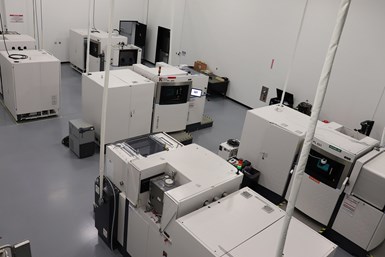KAM Installs More EOS 3D Printers at Manufacturing Facility
KAM’s additive manufacturing capability now includes a comprehensive fleet of 20 large and midsize additive machines alongside 12 multi-axis CNC machine tools for an integrated advanced manufacturing supply chain.
KAM installed two more EOS M400-4 3D printers for a total of 20 additive machines on its manufacturing floor. Photo Credit: KAM
Keselowski Advanced Manufacturing (KAM) says it is continuing to accelerate its integrated advanced manufacturing production capabilities by installing two more large-platform EOS M400-4 metal additive manufacturing (AM) printers for a total of 20 AM machines. With the additional EOS printers, KAM now offers five large-format EOS machines along with a full complement of midsize machines at its North Carolina facility.
“One of the biggest challenges to our industry is in building end-user confidence in the manufacturing supply chain,” says Brad Keselowski, KAM owner and founder. “The rapid growth in both volume and size of additively manufactured parts must be answered with a corresponding increase in machine bandwidth, material availability and finishing capability.”
This increase in large-format printers is said to parallel the recent industry demand surge for large metal hypersonic parts, heat exchangers, turbomachinery and monolithic components designed for space, aerospace and defense applications. In response, KAM says it is balancing a comprehensive fleet of 20 large and midsize additive machines alongside 12 multi-axis CNC machine tools for an integrated advanced manufacturing supply chain.
Related Content
-
Variable Resistance Valve Trim Achieves Lead Time Reduction Through AM: The Cool Parts Show #69
Baker Hughes is realizing shorter lead times and simplified manufacturing through powder bed fusion to produce valve trims previously assembled from many machined metal parts.
-
Do Distributors Dream of Digital Inventory? Würth Additive Group Does
It’s more than a dream for Würth Additive Group and its parent company, in fact. Along with supplying additive equipment, the group is now developing solutions for sourcing 3D printed parts in a reliable, elastic digital inventory model.
-
ConocoPhillips Sees Oil and Gas Supply Chain Opportunity With Additive Manufacturing
Production of parts when needed and where needed can respond to the oil and gas sector’s multibillion-dollar challenge of holding parts in inventory. The supply chain benefit will justify additive even before the design freedoms are explored.












